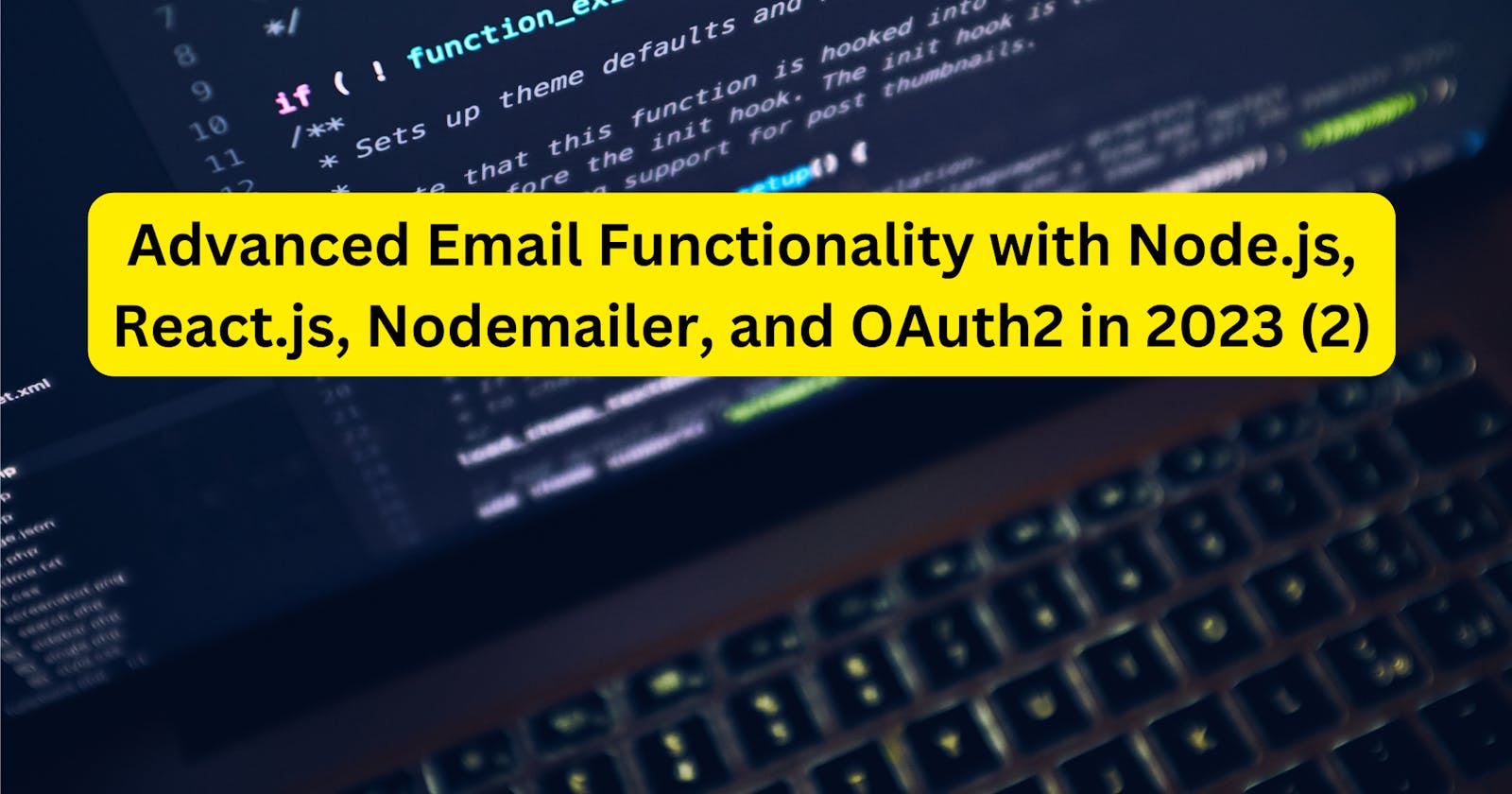Advanced Email Functionality with Node.js, React.js, Nodemailer, and OAuth2 in 2023 (2)
Connecting to Gmail with OAuth2
To securely connect to Gmail using OAuth2, follow these steps:
1. Create Gmail API Credentials:
Go to the Google Cloud Console.
Create a new project.
Enable the Gmail API for your project.
Under Credentials, create an OAuth Client ID.
Select "Web Application" and set the redirect URL to https://developers.google.com/oauthplayground.
2. Obtain Client ID and Client Secret:
Grab the Client ID and Client Secret generated in the previous step.
3. Install googleapis Library:
Install the googleapis library for integration with Google’s APIs:
bash
npm install googleapis
4. Configure OAuth2 Playground:
In OAuth Playground:
Click the settings gear -> OAuth2 configuration.
Check "Use your own OAuth credentials."
Enter your Client ID and Client Secret.
Close settings.
5. Obtain Refresh Token:
Select "Gmail API v1" from the list of APIs.
Click "Authorize APIs" and grant access to your account.
Click "Exchange authorization code for tokens."
Grab the refresh_token value provided; this is crucial for generating access tokens.
6. Store Credentials in .env File:
Update your .env file with the obtained credentials:
env
EMAIL_USER=yourgmailusername
EMAIL_PASS=yourgmailpassword
OAUTH_CLIENT_ID=xxxxxxxxxxx
OAUTH_CLIENT_SECRET=xxxxxxxxxx
OAUTH_REFRESH_TOKEN=xxxxxxxxxx
Replace the values for OAUTH_CLIENT_ID, OAUTH_CLIENT_SECRET, and OAUTH_REFRESH_TOKEN with your credentials. Never commit this file to source control for security.
Building the Email API Routes
Create routes for general emails, confirmation emails, and password reset emails:
1. General Email Route (routes/email.js):
javascript
const router = require('express').Router();
const nodemailer = require('nodemailer');
router.post('/', async (req, res) => {
try {
const { to, from, subject, html } = req.body;
const mailOptions = { from, to, subject, html };
const info = await transporter.sendMail(mailOptions);
return res.json({ message: 'Email sent successfully' });
} catch (error) {
return res.status(500).json({ error: error.message });
}
});
module.exports = router;
2. Confirmation Email Route (routes/confirm.js):
javascript
const router = require('express').Router();
const emailTemplate = require('../templates/email-confirmation');
router.post('/', async (req, res) => {
try {
const { email, name, items, total } = req.body;
const template = emailTemplate.replace('{{name}}', name).replace('{{items}}', items).replace('{{total}}', total);
const mailOptions = { from: '"Company Name" <company@email.com>', to: email, subject: 'Your order confirmation', html: template };
await transporter.sendMail(mailOptions);
return res.json({ message: 'Order confirmation sent!' });
} catch (error) {
return res.status(500).json({ error: error.message });
}
});
module.exports = router;
3. Password Reset Route (routes/reset.js):
javascript
const router = require('express').Router();
const emailTemplate = require('../templates/password-reset');
router.post('/', async (req, res) => {
try {
const { email, name, resetUrl } = req.body;
const template = emailTemplate.replace('{{name}}', name).replace('{{resetUrl}}', resetUrl);
const mailOptions = { from: '"Company" <company@email.com>', to: email, subject: 'Password reset request', html: template };
await transporter.sendMail(mailOptions);
return res.json({ message: 'Password reset email sent!' });
} catch (error) {
return res.status(500).json({ error: error.message });
}
});
module.exports = router;
Creating the React Form
Build a simple React form for capturing user data to send emails. Replace App.js in your React project with:
javascript
import { useState } from 'react';
function App() {
const [email, setEmail] = useState('');
const handleSubmit = async (e) => {
e.preventDefault();
// Send email API request
};
return (
<div className="app">
<h1>Send Email</h1>
<form onSubmit={handleSubmit}>
<input
placeholder="Email address"
value={email}
onChange={(e) => setEmail(e.target.value)}
/>
<button type="submit">Send Test Email</button>
</form>
</div>
);
}
export default App;
Connecting to a Database
To connect to a database, install Mongoose:
bash
npm install mongoose
Then, connect to MongoDB in index.js:
javascript
const mongoose = require('mongoose');
mongoose.connect(connectionURI, {
useNewUrlParser: true,
useUnifiedTopology: true
});
const db = mongoose.connection;
db.on('error', err => {
// error handling
});
db.once('open', () => {
// connected
});
Adding Email Scheduling
Incorporate the Agenda library to schedule and queue emails. Install Agenda:
bash
npm install agenda
Configure and use Agenda in index.js:
javascript
const Agenda = require('agenda');
const agenda = new Agenda({ db: { address: connectionURI } });
agenda.define('send email', async job => {
// send email here
});
(async function () {
// Start scheduler
await agenda.start();
// Schedule email for future
await agenda.schedule('in 20 minutes', 'send email', {
to: 'test@example.com',
subject: 'Scheduled Email',
body: 'This email was scheduled!'
});
})();
Now, you can queue emails and schedule them for future delivery using Agenda.
Any interested in a dedicated team on demand? Explore with us to transfer your business to the next level!
